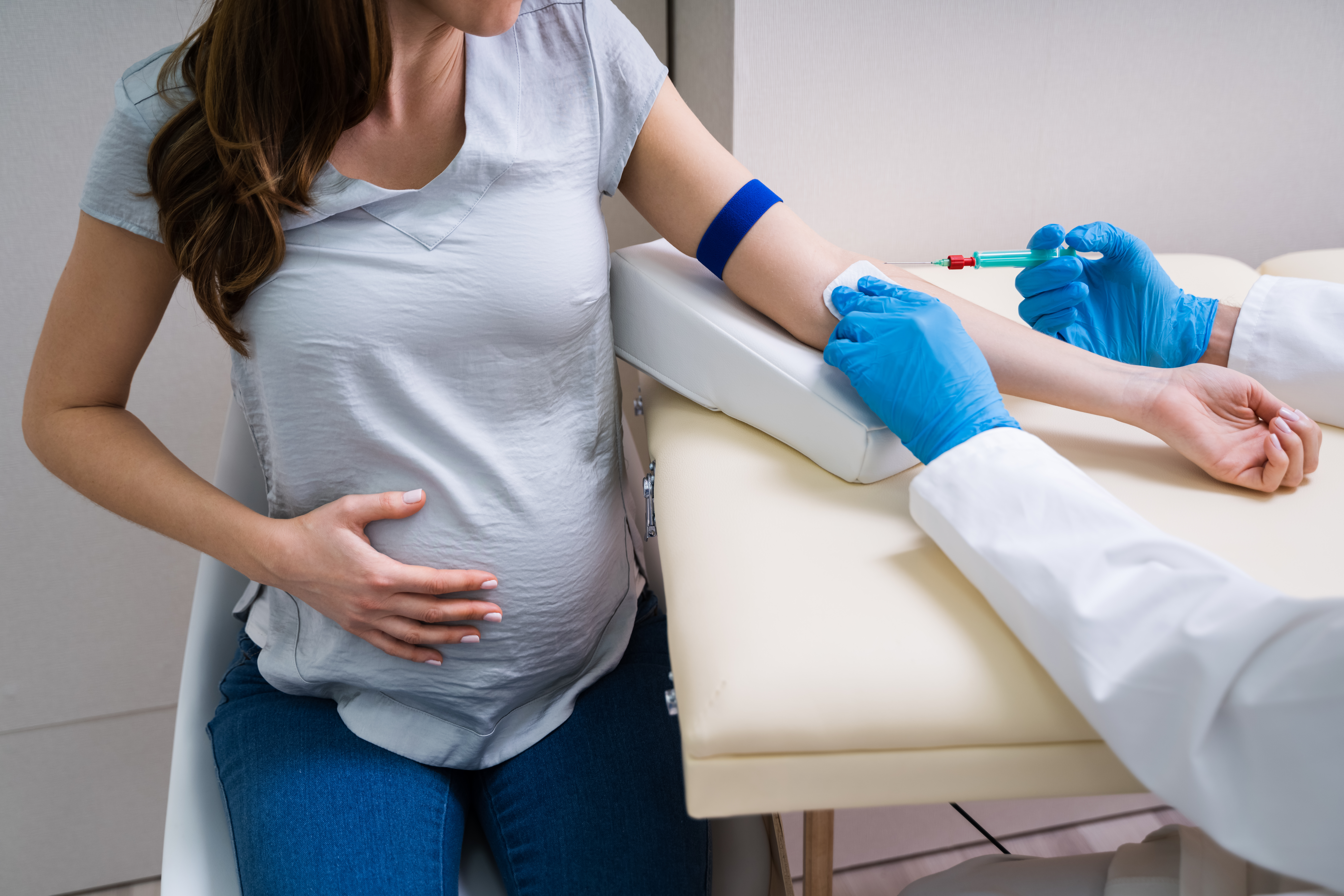Gestational diabetes is a condition that occurs when a woman without diabetes develops a high blood sugar level while pregnant. It typically develops between 24 and 28 weeks of pregnancy.
If not properly treated, the raised blood sugar can affect your and your baby’s health. If left untreated, the condition can lead to a stillbirth. If poorly treated, the baby may be at a high risk of being born too large, having low sugar after birth, increased risk of respiratory distress syndrome and jaundice.

Yearly, between 2 and 10% of pregnant women in the United States get gestational diabetes. The percentage is the lowest for women under 20 years old and the highest for women above 40.
Gestational diabetes is most often associated with a decrease in the sensitivity of the woman's body to insulin, which is caused by a natural increase in the level of certain hormones during pregnancy. Insulin is a hormone produced by the pancreas that lowers the glucose concentration in the blood, causing it to move from the blood into the body's cells. During pregnancy, the concentration of hormones that have an anti-insulin effect![]() increases. These are:
increases. These are:
This may result in insulin resistance, hyperglycemia, increased demand for insulin, and faster occurrence of complications caused by diabetes. However, not every pregnant woman gets gestational diabetes. Most of them, the body can adapt to changes and correct glucose levels. In some women, additional risk factors, such as obesity, heart disease, high blood pressure, or low physical activity, contribute to diabetes development.
In the second and third trimesters, glucose metabolism deteriorates, and the body’s need for insulin increases, which is caused by hormonal and metabolic changes.
Gestational diabetes usually develops between the 24 and 28 weeks of pregnancy. This is due to the beginning of the development of an organ located inside the uterus during pregnancy – the placenta – which is already mature and begins to produce large amounts of hormones that reduce the sensitivity of the woman's body tissues to insulin. Too low tissue sensitivity to insulin causes the glucose concentration in the pregnant woman's blood to be too high, which may result in complications for her and the fetus.
The need for insulin decreases between the 38th and 40th week of pregnancy, which is caused by increased insulin secretion by the fetus.
Usually, high blood sugar during pregnancy doesn’t cause any symptoms![]() . If it does, the following may appear:
. If it does, the following may appear:
If you notice some of those symptoms while pregnant, it doesn’t necessarily mean you have gestational diabetes. Pregnancy itself is associated with a variety of body changes and symptoms that may resemble those during diabetes. However, telling your midwife or doctor if you experience any symptom that makes you worry is essential.
Because usually there are no symptoms or warning signs that alert of pregnancy diabetes development, it is crucial for every woman to get tested for it during pregnancy. The test usually happens between 24 and 28 weeks of pregnancy. The exception is women, who have a higher chance of the condition’s development.
Some women are at a higher risk of getting gestational diabetes. The risk factors include:
Every pregnant woman is tested for gestational diabetes between 24 and 28 weeks of pregnancy. During that time, the placenta (an organ that forms inside the uterus and provides the developing fetus with all the nutrients and oxygen needed) starts producing many hormones. The hormone produced by the placenta interferes with insulin and makes body cells more resistant to insulin, which can result in high blood sugar levels.
Suppose a woman is at a higher risk of getting it (such as if she is having obesity, heart disease, high blood pressure, or a personal or family history of gestational diabetes). In that case, she will probably be tested during her first visit after she becomes pregnant.
The tests used in detecting pregnancy diabetes include:

First, your physician may do the glucose challenge test, also called the glucose screening test. During that test, a pregnant woman is asked to drink sweet fluid with a high glucose concentration. This test doesn’t require fasting (not eating or drinking anything except water before the test). If a test shows too high glucose levels (140 or more![]() ), you most likely will be asked to return for a glucose oral tolerance test on an empty stomach. A glucose level of 200 or more suggests the possible existence of type 2 diabetes that hasn’t been diagnosed before pregnancy.
), you most likely will be asked to return for a glucose oral tolerance test on an empty stomach. A glucose level of 200 or more suggests the possible existence of type 2 diabetes that hasn’t been diagnosed before pregnancy.
For the oral glucose tolerance test (OGTT), you must come on an empty stomach, meaning you can’t eat or drink anything except water for 8 hours before the test. The first step of this test is the blood draw. Next, you will be given a sweet drink containing glucose that you need to drink within a few minutes. Then, you will be asked to sit calmly in a waiting room, and the healthcare professional will draw your blood again in regular intervals – every hour for 2 to 3 hours.
An oral glucose tolerance test shows how your body handles glucose intake. Gestational diabetes is recognized if the test results![]() are:
are:
Sometimes, only some of the test results are incorrect – your physician will discuss your results and explain what your results mean.
If the test results show that you have gestational diabetes, you may have to visit a nutrition specialist who specializes in diabetes during pregnancy. They will discuss your diet and modifications that need to be done in detail. You can discuss specific dishes and products recommended for women with gestational diabetes.
If you are diagnosed with pregnancy diabetes, your midwife or gynecologist will train you in self-testing of glucose levels at home and instruct you how often you should do it. Currently, glucose sensor devices![]() can be applied once every two weeks to monitor glucose levels constantly. The levels from those sensors can be easily read on the phone, and no need for daily pricking to check the glucose level significantly increases the pregnant woman’s comfort.
can be applied once every two weeks to monitor glucose levels constantly. The levels from those sensors can be easily read on the phone, and no need for daily pricking to check the glucose level significantly increases the pregnant woman’s comfort.
It is necessary to treat gestational diabetes since untreated disease can lead to dangerous complications for the mother and fetus. It increases pregnant women’s chances of having Cesarean birth (C-section), preeclampsia, and type 2 diabetes. Furthermore, it raises the risk of:
Treatment of pregnancy diabetes includes healthy eating and regular physical activity. However, for some women, this is not enough to keep blood sugar levels within the norms, and they require diabetes medications.
If you are diagnosed with gestational diabetes, your obstetrician will probably tell you that you need more frequent checkups to control your glucose levels and check the baby’s growth on the ultrasound. You will also have to monitor your glucose levels at home using a glucose meter or glucose sensor device, which is applied once every two weeks, and monitor glucose levels 24 hours a day.
When you have gestational diabetes, you need to adjust your diet![]() . The diet aims to reduce the risk of obstetric complications in the woman and the developing fetus by lowering blood glucose levels. Caloric needs depend on age, BMI before pregnancy, physical activity, and pregnancy stage.
. The diet aims to reduce the risk of obstetric complications in the woman and the developing fetus by lowering blood glucose levels. Caloric needs depend on age, BMI before pregnancy, physical activity, and pregnancy stage.
After diagnosis, a nutrition expert will likely be your next stop, offering advice on altering your eating habits. Some pointers could feature:

If there are no contraindications, experts recommend moderate physical activity during pregnancy, especially in the case of gestational diabetes. The exercise regimen a woman follows largely depends on her pre-pregnancy lifestyle. If she was already active before the pregnancy, continuing this physical activity is suggested with some adaptations for safety during pregnancy and reducing chances of accidents.
Women who weren't engaging in regular workouts before becoming pregnant should add more exercises into their routines progressively. Activities recommended for pregnant ladies include:
If the lifestyle modifications aren’t enough to keep your glucose levels within the recommended target, after 1 to 2 weeks, you might be given diabetes medicine![]() . Your doctor may prescribe you medications immediately after being diagnosed if your glucose levels are exceptionally high.
. Your doctor may prescribe you medications immediately after being diagnosed if your glucose levels are exceptionally high.
The medicines are supposed to make your body cells more sensitive to insulin or to provide more insulin. You usually can stop taking them after giving birth.
Untreated or poorly treated gestational diabetes may cause many severe complications for pregnant women and fetuses.
The dangers that gestational diabetes poses to the mother include frequent urinary tract infections, the risk of miscarriage, increased blood pressure, and polyhydramnios, i.e., excessive amniotic fluid.
Another dangerous complication that occurs more frequently in women with gestational diabetes is preeclampsia. Preeclampsia is a severe pregnancy disorder caused by abnormal blood flow in the placenta, which causes hypertension (high blood pressure) in the pregnant woman and fetal hypoxia (low oxygen level).
Moreover, gestational diabetes is a significant risk factor![]() for developing type 2 diabetes later in a woman's life. The fact that the body cannot cope with the challenge of pregnancy already shows a particular impairment in the body's ability to deal with glucose. Typically, insulin resistance worsens with age.
for developing type 2 diabetes later in a woman's life. The fact that the body cannot cope with the challenge of pregnancy already shows a particular impairment in the body's ability to deal with glucose. Typically, insulin resistance worsens with age.
Following childbirth, it's important for females who have experienced gestational diabetes to continue with a lifestyle that promotes wellness and activity. Priorities include sustaining appropriate body weight, having plenty of variety in your nutritious food choices, and ensuring there's some time spent regularly for physical activities.
You can help keep blood sugar healthy by adhering to the dietary guidance you followed during pregnancy. This includes staying away from eating sizeable meals and refraining from simple carbs consumption. Staying away from junk food and sweetened drinks is also advised. The basis of the menu should be complex carbohydrates, valuable protein, fiber-rich vegetables, and fruit.
Children of mothers with gestational diabetes are at risk of congenital heart disorders, kidneys, and nervous system diseases. A common effect of gestational diabetes is the so-called hypertrophy, meaning too high birth weight, over 4 kilograms. However, the opposite situation may also happen when the child is born very small, called hypotrophy, which may result from hyperglycemia during the fetal period. Gestational diabetes itself can also cause delays in fetal development and contribute to the death of the baby during delivery.
After birth, the baby is at risk of hypoglycemia (too low sugar levels), breathing disorders, seizures, and an increased risk of obesity later in life![]() .
.
In most women with gestational diabetes, the glucose levels normalize after delivery. It is crucial to get tested for diabetes between 6 to 12 weeks after delivery. If your glucose levels are still incorrect after birth, it means that you have type 2 diabetes that was found during pregnancy.
Even if diabetes passes after delivery, it is important to keep in mind that your chances of delivering type 2 diabetes in the future are much higher now. Also, in your subsequent pregnancy, the chances that you will experience pregnancy diabetes again are higher than in others.
Before pregnancy, maintaining a healthy weight and regular physical activity can help prevent gestational diabetes development. However, there is no one way to make sure you won’t get it while pregnant.
Remember not to lose weight when you’re already pregnant. During pregnancy, gaining some weight is necessary for a baby to be born healthy. If you are in the risk group of pregnancy diabetes, talk to your midwife or obstetrician about steps you can take to make sure your baby will be born healthy.